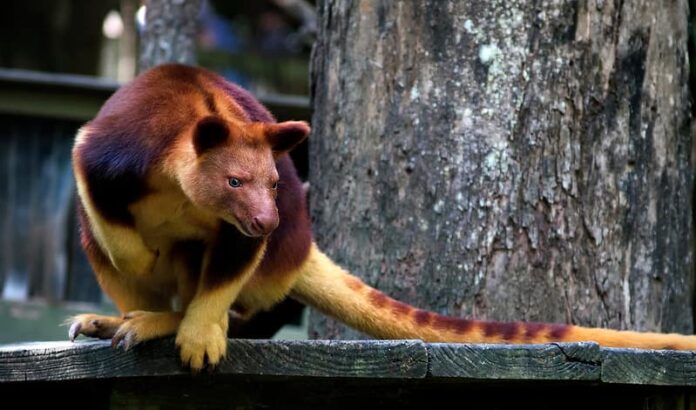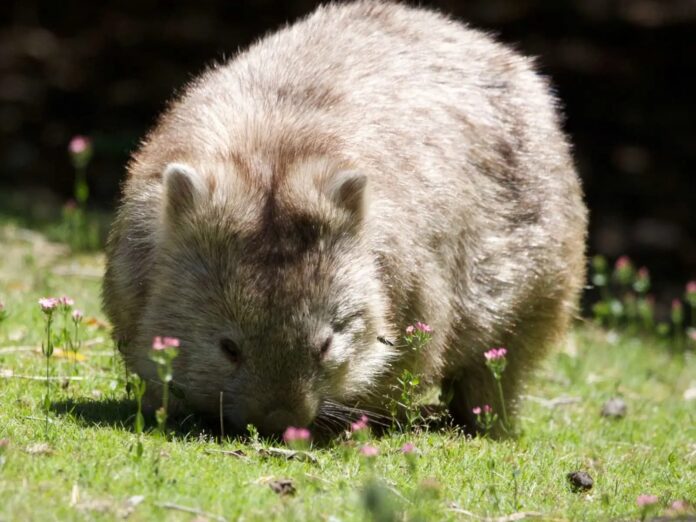Marsupials are adult females that have a marsupium aka a pouch on the outside of the body, are very fascinating mammals. When it comes to a pouched animal, there is one common animal that comes to your mind. To expand the knowledge of these animals, we are here to introduce you to some large marsupials today. There are over 250 marsupial species at the moment, but most of them are quite small in size. This is why large marsupials are not the topic that comes across every day. You will find only 5 of them below, so let’s see which one among them that you like the most.
1Kangaroo

Everybody knows kangaroos, the jumpy animals of Australia. Kangaroos are very much like a T-rex if you ask me, with their small front legs, powerful hind legs, and a strong tail. However, they may be better because their large feet of theirs allow them to jump over 9 meters (30 feet) in a single bound. These jumpy marsupials are also fast because they can hop more than 48 kilometers (30 miles) per hour. Even more interesting, kangaroos can also use their tails for balance while jumping. Those tails also help these good swimmers to trick and drown their opponents as well.
The most fascinating feature about kangaroos is that the females have a pouch on their bellies. The sole purpose of this pouch is to cradle baby kangaroos called joeys. Newborn joeys are about the size of a grape, this is why they need comfort and safety inside their mother’s pouch. At the same time, newborn joeys can’t suckle or swallow, so the mom uses her muscles to pump milk down its throat. The joeys will emerge from the pouch for grazing and short trips when they are around 4 months. When they are about 10 months old, the joeys will be mature enough to leave the pouch.
Kangaroos are not only the largest marsupials but also the tallest marsupials, standing over 2 meters (6 feet) tall. Living in small groups called herds or troops (or mobs by Australians), the members can up to 50 or more. Maybe some of you know that they are strong fighters will their powerful punchy punches, but there’s more. If threatened, kangaroos will pound the ground with their strong feet to alert and warn the others in the group. When fighting, they will bite, kick, and punch their opponents. As the largest marsupials, kangaroos are very strong so picking a fight with them is a bad choice.
Fun Fact: There are more kangaroos in Australia than there are Australian people.
2Koala

Here we have another famous star of Australia, Koalas the sleepy marsupials that spend up to 18 hours snoozing. You can find them living high up in eucalyptus trees of native bushlands and forests, where they feed. So how can a heavy and large marsupial live between tree branches their whole life like that? Koalas have strong cartilage at the end of their curved spines, and these strong butts are extremely supportive. Up there, koalas feed on eucalyptus leaves that are actually poisonous to most animals out there. Despite being sleepy, these fluffy marsupials are quite picky since they often choose leaves at the top of the trees. This is to absorb the most liquid and nutrients possible since they don’t come down to drink water.
Baby koalas are born blind and earless, but they have a strong sense of smell and touch. Just like kangaroos, baby koalas are called joeys and they live in their mother’s pouch. The unique thing about the pouch is that it is backward-facing so that the joeys will not fall out. In there, they simply feed and sleep until it is time for them to change their place. Koalas joeys develop in the pouch for about 6 months before they move to ride on the mom’s back instead. This lasts for another 6 months until the joeys can climb trees and feed by themselves. Nowadays, their population is declining due to habitat loss as a result of agriculture, clearing, forest fires, and fragmentation.
Fun Fact: The correct name is Koala, not koala bear because they are marsupials with no relation with bears at all.
3Tree Kangaroo

Looks like a combination of a kangaroo and a koala, tree kangaroos are the least famous in the marsupial family. They inhabit the lowland and mountainous forests of Australia, Indonesia, and Papua New Guinea. Tree kangaroos live and spend most of their time in trees, and they have strong arms and legs. Along with that, they have long curved claws that allow them to climb higher than a 10-storey building. When they need to move to a different tree, tree kangaroos either come down to the ground or jump from tree to tree. The best part is their super long tail that helps them to balance on tree limbs. Another strength that they have is the strong upper front teeth that they use to cut leaves and stems.
Yes, female tree kangaroos have a pouch where they joeys safely live and rest inside. The babies of these largest tree-dwelling marsupials and mammals live with their mothers for about 10 months. During this phase, the mother will often clean her pouch and groom the joey. The joey will leave the pouch at 8 months old, but it will return to the pouch to nurse. Joeys will stay with their mothers until they are around 18 months old when they disperse and establish a home range. Female and male tree kangaroos have non-overlapping home ranges, and they are solitary.
There are about 12 different species of tree kangaroo, and most of them are at risk. Not different from koalas, tree kangaroos are on the brink of extinction because of habitat loss resulting from deforestation. People clear the forests which are their homes to build cities, grow crops, harvest wood, raise livestock, and more. Their population is also threatened in New Guinea because people hunt them for food. Besides, logging and mining exploration also greatly affects their population in the wild as well.
Fun Fact: Tree kangaroos are polygamous, so one male often mates with several different females.
4Wallaroo

At a quick glance, there is nothing different between a kangaroo and a wallaroo. If you look closely though, wallaroo has a more stocky build with coarse shaggy fur without muzzle hair. At the same time, they have a short and thick tail with an upright hopping style. Another difference between them and the kangaroos is that they have short limbs to adapt to leaping around rocks. Wallaroos are found throughout most parts of Australia, except Tasmania. This marsupial species lives in caves and rock formations with large overhangs, rocky hills, shrubland, and places near water sources.
A female wallaroo gives birth to a single joey, and she nurses it inside her pouch for about 6 months. The interesting them is that joeys sometimes fall out of the pouch, but they quickly climb back in. Weaning usually takes place when the joey is about 15 to 16 months. The mother waits until waning before she mates again. Wallaroos are nocturnal and solitary, and the males sometimes fight or box with each other using their powerful feet. This is to display dominance to gain access to mate with females or maintain social hierarchy. Wallaroo means “rock kangaroo”, and it got its name because it is larger than a wallaby but smaller than a kangaroo.
Fun Fact: When a wallaroo’s front teeth wear down, they fall out. Then the fresh ones will appear at the back of its mouth, pushing the whole row forward.
5Wombat

Wombats are very fascinating creatures with ever-growing teeth and a fast-running speed of 40 kilometers (24 miles) per hour. Wombats are around 101 centimeters (40 inches) when standing, making them the second largest marsupials in the world. Surprisingly, wombats are the closest relatives of koalas despite the fact that they look nothing alike. The one thing that they both share is actually the unique backward-facing pouches. Because wombats dig a lot, this unique-designed pouch protects the baby inside from dirt while digging. As nocturnal animals, wombats spend their night digging entrances, exits, and new tunnels, or foraging for food.
These large marsupials have a booty that mainly consists of cartilage which they use as their main form of defense mechanism. When threatened, they dive into the tunnel headfirst because their rump is not only strong but also bite and scratch resistant. On top of that, they also use it to crush predators’ skulls with proof to prove in their dens. Wombat’s poop is a cubic shape, and they use it to mark territory. Wombats are territorial, so they can be quite aggressive toward intruders. This is why there are reports of human injuries from wombat attacks including puncture wounds from their claws and deep bites.
Fun Fact: During bushfires, wombat’s huge burrows become shelters for many other animals such as bettongs, little penguins, rock wallabies, etc. The burrow can contain tunnels over 200 meters long that remain cool during the fire, offering protection from the flames.
Related Post: Animals With Cheek Pouches




